|
Micscape Snippets 2 - On who first described rotifers and when?
An example of how attributions change ... but which is now regarded as correct
from the conflicting information presented both offline and online?
by David Walker,
UK
|
Series
Introduction: Occasional random jottings by the Micscape Ed.
The question in the title seems at first glance straightforward enough but a browse around the Web and offline resources shows that there's a certain amount of conflicting information available. The likely reasons for these conflicts are mixed and provides some interesting insights on how they can occur and in recent years how the Web can favour the dissemination of one attribution in particular, John Harris in
1696—even though it has not
been regarded as the correct one for over a century.
There's two commonly cited contenders, John Harris in 1696 and Antoni van Leeuwenhoek, but for the latter with various dates cited, in particular 1674, 1676, 1687, 1702 and 1703.
|
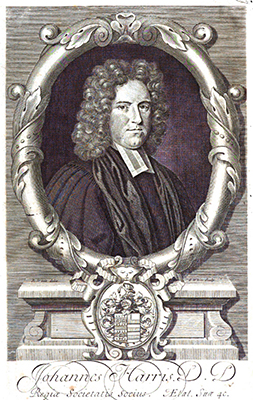
An engraving of John Harris D.D. F.R.S. from the frontispiece of volume 1 of his two volume 'Lexicon Technicum' 1708, which Wikipedia notes "was in many respects the first alphabetical encyclopedia written in
English". Now in the public domain on Google Books.
|
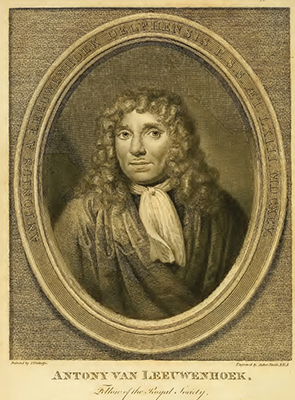
A portrait by Johannes Verkolje of Antony van Leeuwenhoek F.R.S. from the frontispiece of Hoole's 'The Select Works of Antony van Leeuwenhoek', published in two vols. ca. 1800. Now in the public domain at www.archive.org.
|
John Harris. On July 7th 1694, John Harris then Rector of Winchelsea, Sussex studied and described the microorganisms which he had observed in rainwater that had been standing in a 'Gally-Pot* in my Window'. They were reported in the Royal Society's Philosophical Transactions
in 1696 and
key passages are highlighted in red below.
* "Gallipot. A small earthen glazed pot, esp. one used by apothecaries for ointments and
medicines". Source - the online Oxford English Dictionary.
His description of a microorganism in a 'small drop' of water akin to a 'maggot' that contracts and stretches and has a 'forceps' like tail could be referring to a rotifer species with these features, especially in the habitat described. C T Hudson and P H Gosse in their classic monograph The Rotifera ; or Wheel-Animalcules
of 1886 (see scan below) cite this as
the earliest description of a rotifer but with some qualification:
"This description is but vague ; and yet it is very probable that the animal which the rector found in his gallipot was a Rotifer : and if so, this is the earliest notice that we have found of the class.'
|
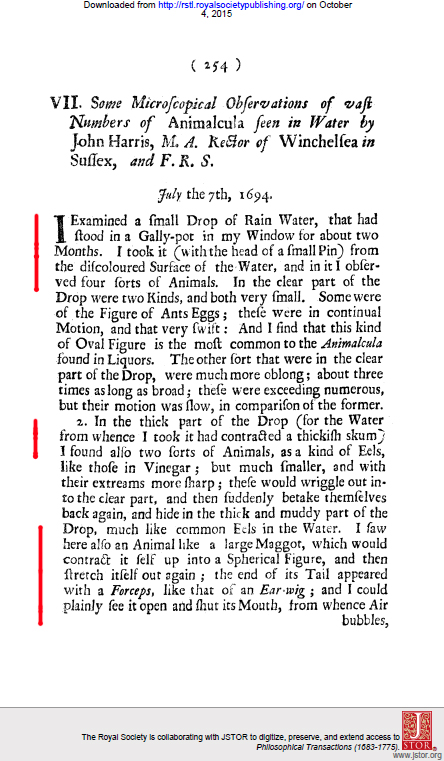
|
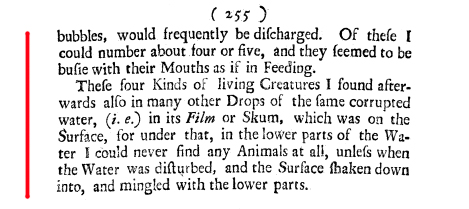
Left and above. Pages from Phil. Trans. 1696, 19, 254-25. 'Some Microscopical Observations of vast Numbers of Animalcula seen in Water' by John Harris, M. A. Rector of Winchelsea in Sussex, and F. R. S.'
With thanks to the Royal Society who have generously uploaded the entire archive of Transactions with older Transactions now in the public domain.
|
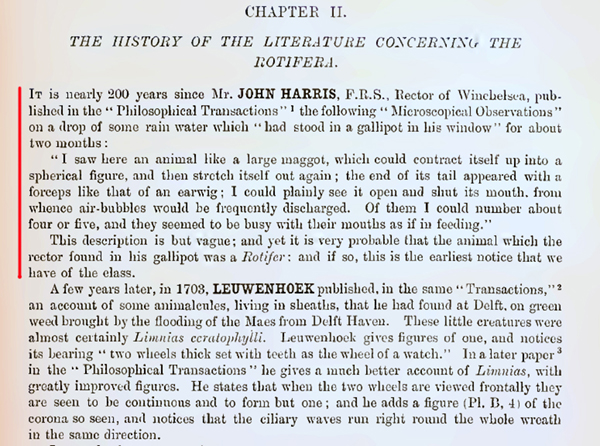
Above. 'The Rotifera or Wheel Animalcules' by C T Hudson and P H Gosse published in 1886. Page 15 extract from a copy on www.archive.org
and now in the public domain. The website has multiple copies of Volumes 1 and 2 and the Supplement in various online and downloadable formats.
In a slightly earlier publication dated 1880-1881, W Saville Kent in his A Manual of the Infusoria Vol. 1 (p.9) also remarks on Harris's paper and notes that the rotifer is 'probably R. vulgaris'.
Present specialists in the field no longer regard Harris's 1696 report as the earliest, but Koste and Hollowday in 1993 (2) note that (my underlining):
"Possibly the first published mention of a rotifer in Britain was that by John Harris (1667?-1719), who published an account (1696) of what may well have been a creeping bdelloid from rainwater in a pot on his window ledge."
(2)
In the same paper these authors attribute the earliest report to that by Leeuwenhoek in his letter dated October 17th 1687 as remarked on later.
The attribution of the first rotifer observation to Harris continued in some printed publications, e.g. the 'Rotifer' entry by Marcus Hartog in the 1911 edition of Encyclopaedia Britannica and occasionally more recently in print. A reviewer (1) of the English translation
in 1966
of Joseph Donner's splendid and now classic monograph Rotifers reverts the now accepted attribution stated on
the dustcover from Leeuwenhoek (giving 1703 rather than 1687) back to Harris in 1696.
As a hobbyist, I'm not sure exactly when the attribution was firmly revised to Leeuwenhoek rather than to Harris—this may be recorded in one or more of the papers on rotifers distributed in many different journals, which aren't always easy to access if not affiliated to an institution. But of readily available literature, L C Miall DSc FRS in his delightful The
Early Naturalists
Their Lives and Work (1530-1789) published in 1912, in his discussion of Leeuwenhoek's rotifer studies attributes the first report to Leeuwenhoek in 1687 (3) i.e. also the firm date agreed upon by modern workers. It's worth noting that Miall was citing contemporary Latin publications of Leeuwenhoek's letters—the key letter
dated 17th October 1687 was not published in English
in the Philosophical Transactions—earlier writers may not have had access to Latin volumes of the letters.
However, from a straw poll of Google typical keyword searches related to rotifer discovery, the citation of Harris in 1696 as the earliest report of a rotifer seems to be the current dominant attribution in non-specialist resources. The most likely reason is that the web resources are citing the
current
entry for 'Rotifer' on Wikipedia and also mentioned in the entry for 'John Harris' (both accessed Oct. 5th 2015) which reads:
Wikipedia references Harmer and Shipley's 1896 'Cambridge Natural History' (4) which in turn cites Hudson and Gosse 1886.
Wikipedia has become a superb resource and is frequently the first reference sought by many on a topic, including myself for a wide range of subjects. But the unsung dedicated writers of each entry if not aware of the accepted modern attribution of an aspect of the history of science, can inadvertently disseminate out of date information because so many sources cite Wikipedia.
For example, an extensive series of
educational eBooks for students with an entry for rotifer all use the 1696 Harris attribution as do a wide range of other sources. It can be increasingly difficult to reverse this trend even if the Wikipedia entry is updated (the Wikipedia Talk page for 'Rotifer' does remark on the out of date attribution).
Antoni van Leeuwenhoek. As noted in the introduction, a range of dates are cited for Leeuwenhoek's first description—both well before Harris's report of 1696 and also a little later. The variation in dates may reflect Leeuwenhoek's prolific output discussing microorganisms and that as noted below, some key letters were not readily available in English until the ongoing Collected
Letters published from 1939 (11). Cole's meticulous compilation in 1937 of Leeuwenhoek's zoological researches (5,6) lists nine published letters
where there's either a firm or possible
description of rotifers and the four letters below published in 1674, 1687, 1702 and 1703 have been selected from this list.
When deciding who first described a type of microorganism e.g. rotifers and when, the historian and expert in a given group is faced with a problem. The potential earliest report may be a text description without an illustration and the microscope in use at the time by a worker, no matter how diligent, may not reveal key features to enable a modern reader to incontrovertibly decide what organism was being
described. Hudson and Gosse as noted earlier regarded Harris's description as 'vague' and Cole was careful to note in his compilation of Leeuwenhoek's work that firm identification of a number of Leeuwenhoek's descriptions was difficult.
When walking in the footsteps of historians / rotiferologists to see how they firmly assigned a date to Leeuwenhoek's first description, it's useful to work backwards in the key letter dates because the potential rotifer reports change from the certain to the more debatable. Only brief comments on these letters are made below—for a splendid illustrated survey
and analysis of Leeuwenhoek's rotifer studies
see Brian J Ford's paper (7) and also see Dobell's classic work (10).
Two superb free resources have been placed online in recent years which are of great value to those wishing to study Leeuwenhoek's work: 1) The archive of the Royal Society's Philosophical Transactions are online where many of his letters sent to the Society in whole or part were published; 2) the definitive complete English
translations of
Leeuwenhoek's letters with plates in the Collected Letters vols 1-15 (11) on the www.dbnl.org website (vol. 16 was published
in print in 2014). Links are provided to the relevant entries below.
Letter dated 25th December 1702 to the Royal Society and part published in Phil. Trans, 1703 (Collected Letters no. 239, vol 14, pub. 1996). This letter has detailed drawings of rotifers accompanying the clear descriptions. The date 1703 is quite widely cited as being Leeuwenhoek's own first report of rotifers,
both in the older and more modern literature e.g.: 1886 - Hudson and Gosse's The Rotifera, this was the earliest date they cited for his work; 1966 - the dustcover as remarked of the English translation of Donner's Rotifers; 2001 R W Pennak in his Freshwater Invertebrates on the
United States (the current 4th edition and earlier).
|
Right: Plate (a crop) of a root of duckweed showing the epiphytic organisms observed. A rotifer is clearly figured at Q and R. The plate accompanies the letter published in Phil. Trans., 1702-1703, vol. 23, 1304-1311.
The editor's of the Collected Letters in their equivalent plate, assign Q (abc) to Melicerta ringens and R (zxy) to Limnias ceratophylli respectively. P (def) is assigned to the ciliate Cothurnia crystallina.
'Part of a letter from Mr Antony van Leeuwenhoek, F.R.S. concerning green Weeds growing in Water and some Animalcula found about them.'
With thanks to the Royal Society who have generously uploaded the entire archive of Transactions with older Transactions now in the public domain.
|
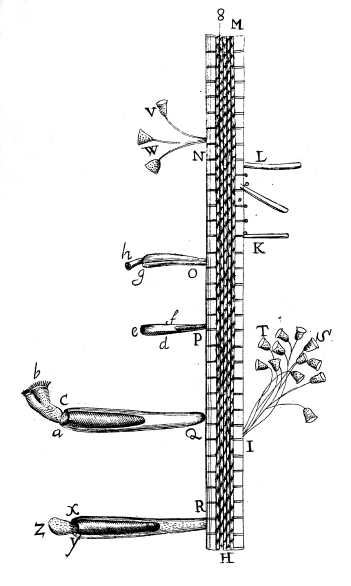
|
Letter dated 9th February 1702 to Hendrik van Bleyswijk (Collected Letters no. 233 [144], vol 14, pub. 1996) As Dobell and
later Ford illustrate, this is the earliest Leeuwenhoek letter where a description is accompanied with clear illustrations (shown below) and which are immediately recognisable as rotifers (in this case bdelloid). This is not as widely cited cf the 1703 letter, possibly because it was not sent to the Royal Society and not published in Philosophical Transactions. Hoole in his Select Works (8) did show these figures but did not associate letter extracts and figures with specific dated letters. Although
Hoole's work is a well regarded translation (Dobell, (10), p.410), the Select Works was not suited for identifying the potential earliest dated reports. The figures from a contemporary Latin edition of the letters are shown below as they are better transcribed than those in the online copies of Hoole.
|
Right. Plate to accompany Leeuwenhoek's letter no. 144 to Hendrik van Bleyswijk dated 9th February 1702 published in Latin in 'Opera Omnia', vol. 4, 1719. Figs. 1-2 incontrovertibly show a bdelloid type rotifer when extended. This is shown in Plate
II in the 'Collected Letters' 1996, vol. 14. The editors assign the rotifer to the bdelloid species Philodina roseola.
Hosted on the ECHO website, catalogue entry: 'Leeuwenhoek, Antoni van, Opera omnia seu
arcana naturae ope exactissimorum microscopiorum detecta, experimentis variis
comprobata : epistolis ad varios viros, ut et ad integram, quae Londini floret,
sapientem Societatem, cujus membrum est, datis, comprehensa, & quatuor tomis
distincta; vol. 4: [Continuatio arcanorum naturae], 1719.
ECHO 'source information': Digitised by and images © Max Planck Institute
for the History of Science. The ECHO venture has an 'Open Access Policy' where
public display of works including derivative works is permitted with proper
attribution. Link to plate.
|

|
Letter dated 17th October 1687 to the Royal Society (but not published in Phil. Trans.) (Collected Letters no. 104 [59], vol. 7, pub. 1964) As remarked earlier, this is now regarded as the earliest incontrovertible report
of a rotifer. Leeuwenhoek gives an extended and clear description
of one type of microorganism that from the described features and behaviour is
regarded to be distinctive of a bdelloid rotifer. Koste and Hollowday remark in the introduction to their 1995 paper (2) that from the description in this letter:
In the full English translation in the Collected Letters an editor in a footnote assigns to genus Rotatoria. The editor's note that Hoole published an extract in his Select Works (8). The editor's also remark:
As Koste and Hollowday also note, these samples were rediscovered in 1981 (9) by Brian J Ford in the Royal Society archives attached to the original letter and he was able to show after careful re-exposure of a piece of the algal mat to water that recognisable bdelloid rotifers were present (not revivable to date unfortunately!). His book The Leeuwenhoek
Legacy pub. 1991 is a delightful read where he discusses these
and other samples which he found attached to three letters and studied in detail.
Letter dated 7th September 1674 and published in part in Phil. Trans. (Collected Letters no. 11 [6], vol. 1, pub. 1939) Most of this letter discusses eye structure and other subjects but finishes with a discussion of his study
of samples from 'Berkelse-Lake'. It includes what Dobell regarded to be the first description of Sprirogyra. The relevant short description of a microorganism where it has been raised whether it described a rotifer is quoted in full below from the letter (my underlining):
"... among all which there crawled abundance of little animals [49], some of which
were roundish; those that were somewhat bigger than others, were of an Oval
figure: On these latter I saw two leggs near the head, and two little fins [50] on
the other end of their body:"
An editor's footnote [49] succintly sums up the importance of the observations in this letter in a wider context i.e. this was Leeuwenhoek's first observation that 'little animals' existed:
"The soberly-worded passage in L's letter, therefore, means nothing less
than the discovery of microscopic beings. [K.]"
'K' was 'Dr. Ir. A. J. Kluyver, professor of microbiology at the Technical College of Delft'.
The editor's footnote [50] remarks that:
"Dobell (ibid., p. 110, note 4) thinks it probable that this description
refers to Rotifers. [K.]"
Dobell was a protozoologist and wrote the classic biography on Leeuwenhoek (10) but understandably can only assign 'probable' to this brief description as it does not have the extended description including key features such as the wheels
of cilia noted in the 1687 letter to provide certainty. Koste and Hollowday in their 1993 paper also note that in Leeuwenhoek's letters predating 1687 where he described microorganisms, that some "may well have been rotifers" (2).
The letter was published in part in Phil. Trans. 1674, vol. 9, 178-182. The letter was not indexed in the volume at the time and
is appended to Daniel Coxe's paper p.169-182.
Summary
The currently accepted earliest and incontrovertible description of a rotifer is by Leeuwenhoek in his letter dated 16th October 1687 to the Royal Society. The earliest attribution to him with this letter date is at least 1912 by Miall but could have been earlier. A footnote in The Collected Letters vol 1, pub. 1939, where the complete letter was first translated and published in English, supports this attribution as do recent papers by modern historians.
Leeuwenhoek's 1687 letter was not published in English at the time in Philosophical Transactions. Nineteenth century attributions of a first description to Harris in 1696 may understandably reflect the lack of an available dated English translation
of this key dated letter (which Hoole's undated compilations in Select Works of ca. 1800 did not provide) and possibly the lack of ready access to the non-English publications of the letters.
There are descriptions of microorganisms in Leeuwenhoek's letters predating 1687, with letters in 1676 and 1674 being cited by Dobell, but these descriptions are not detailed enough for historians to incontrovertibly assign any to a description of a rotifer.
In later letters, dated 1702, 1703 and 1704 very fine drawings of immediately recognisable rotifers accompanied Leeuwenhoek's careful observations.
At the time of writing, October 2015, the accepted attribution to Leeuwenhoek in 1687 does not seem to be widely cited in many educational resources online and also in a range of e-books. This may be because the Wikipedia entry for 'Rotifer' and 'John Harris' currently assign the first report to Harris in 1696 and has likely been cited by a wide range of other resources. Those resources that do cite Leeuwenhoek as the first reporter often
cite the 25th December 1702 illustrated letter published in 1703 in Phil. Trans.. The lack of citations to the earlier illustrated letter of 9th Feb. 1702 may reflect it not being published in Phil. Trans.—the first full translation in English being in the Collected Letters in 1996.
Although Micscape does not aspire to be a key resource online for topics covered by its contributors, we are keen to be as accurate as possible and two articles covering rotifers have been updated to reflect the currently accepted 1687 date. Keen readers in the past have pointed out inadvertent factual inaccuracies in various articles and the article contributors and site editors
appreciate it when they do.
The author David Walker is an amateur microscopy enthusiast and neither a historian nor a rotifer expert so welcomes any comments / corrections.
References where not cited in full in text and additional resources (Links where offered are either to a full public domain version, marked *, or access point for affiliated users.)
1) Review by 'H.W.D.' of 'Rotifers' 1966 by Josef Donner, English translation by H G S Wright, Journal of the Royal Microscopical Society, 1966, vol. 86 (2), 201-202.
2) Walter Koste and Eric D Hollowday, 'A short history of western European rotifer research', Hydrobiologia, 1993, vol. 255/6, 557-592.
3) L C Miall, 'The Early Naturalists Their Lives and Work (1530-1789)', 1912, pub. Macmillan and Co. Ltd., p.214, footnote 1.*
4) Sidney Frederic Harmer and Arthur Everett Shipley, (1896). The Cambridge Natural History. 1896, Volume 2, Chapter 8, p.197. The Macmillan company.* (Wikipedia 'Rotifer'
entry ref. 1.)
5) F J Cole, 'Leeuwenhoek's Zoological researches.—Part I', Annals of Science, 1937, vol. 2, no. 1, pp.1-46.
6) F J Cole, 'Leeuwenhoek's Zoological researches.—Part II. Bibliography
and Analytical Index', Annals of Science, 1937, vol. 2, no. 2, pp.
185-235.
7) Brian J Ford, 'The Rotifera of Antony van Leeuwenhoek', Quekett Journal of Microscopy, 1982, vol. 34, 362-373.* Available as a pdf on the author's website.
8) S. Hoole, 'The Select Works of Antony van Leeuwenhoek, Containing His
Microscopical Discoveries in Many of the Works of Nature.' 2 Vols, 1798, 1807.
www.archive.org has both vols. but plates incomplete. Also available in various
modern reprints but plates also incomplete in editions seen.*
9) Brian J Ford, 'The van Leeuwenhoek Specimens', Notes and Records of the Royal Society, 1981, 36(1), 37-59.* Available as a pdf on the author's website.
10) C. Dobell, 'Antony van Leeuwenhoek and his "Little Animals"', first published
1932. Dover Edition 1960.*
11) 'The Collected Letters of Antoni van Leeuwenhoek = Alle de Brieven van Antoni van Leeuwenhoek', 1939 - present. Vols 1 - 15 of the present 16 covering his letters up to 1707 are now generously available online on the www.dbnl.org website.*
Revision history: First published October 13th 2015.
Minor text revisions October 16th, 17th 2015.
©
Microscopy UK or their contributors.
Published
in the October 2015 edition of Micscape.
Please
report any Web problems or offer general comments to the
Micscape
Editor .
Micscape
is the on-line monthly magazine of the Microscopy UK web site at
Microscopy-UK
© Onview.net
Ltd, Microscopy-UK, and all contributors 1995 onwards. All rights
reserved.
Main site is at www.microscopy-uk.org.uk.






